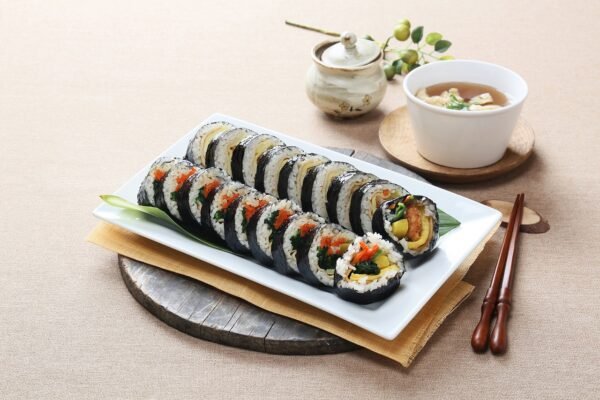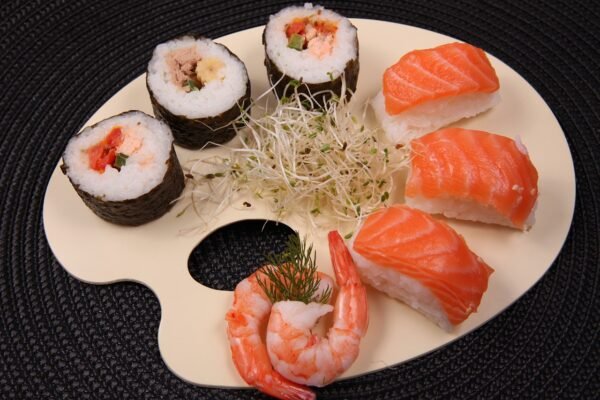Understand the differences between Gimbap and Sushi with our detailed comparison. Perfect for food lovers and curious minds!
Exploring the Delightful World of Kimbap: A Comprehensive Guide

Discover the delicious world of Korean kimbap! From its history to making tips, explore varieties, ingredients, and cultural significance of this iconic Korean food. Perfect for food lovers and Korean cuisine enthusiasts. #KoreanFood #Kimbap
Introduction
Kimbap, often referred to as the Korean sushi, is a beloved dish that holds a special place in Korean cuisine. This versatile and visually appealing food is not only a staple in Korean households but also a favorite among food enthusiasts worldwide. In this comprehensive guide, we delve into the intricacies of kimbap, exploring its history, ingredients, variations, and cultural significance.
The Origins of Kimbap
Kimbap’s origins can be traced back to the early 20th century during the Japanese occupation of Korea. While influenced by Japanese sushi, kimbap has distinctly evolved to incorporate traditional Korean ingredients and flavors. The term “kimbap” translates to “seaweed rice,” highlighting its primary components—gim (dried seaweed) and bap (rice).

Historical Significance
Kimbap emerged as a popular and convenient food item for picnics and travel due to its portability and ease of preparation. Over time, it has become a symbol of Korean culinary tradition and innovation, reflecting the country’s rich cultural heritage.
Key Ingredients and Preparation
Essential Ingredients
- Gim (Seaweed): Dried seaweed sheets are used to wrap the kimbap, providing a subtle umami flavor.
- Bap (Rice): Short-grain white rice, seasoned with sesame oil and salt, serves as the base.
- Fillings: A variety of fillings, including vegetables (carrots, spinach, pickled radish), proteins (beef, fish cake, eggs), and sometimes seafood.
Preparation Method
- Cooking the Rice: The rice should be cooked to a slightly sticky consistency, then seasoned with sesame oil and salt.
- Preparing the Fillings: Vegetables are typically blanched or stir-fried, while proteins are cooked and seasoned appropriately.
- Assembling the Kimbap: Place a sheet of gim on a bamboo mat, spread an even layer of rice, add fillings, and roll tightly. Slice into bite-sized pieces.
Popular Variations of Kimbap
Traditional Kimbap
Traditional kimbap includes classic ingredients like spinach, carrots, pickled radish, and bulgogi (marinated beef). This version is a true representation of Korean flavors and textures.
Tuna Kimbap
Tuna kimbap features a filling of canned tuna mixed with mayonnaise, adding a creamy texture and rich taste. It’s a popular choice for those who enjoy a savory twist.
Vegetable Kimbap
For a lighter option, vegetable kimbap includes a variety of fresh and pickled vegetables, offering a refreshing and nutritious meal. Common ingredients are cucumber, carrot, and spinach.
Cheese Kimbap
A modern twist on the classic, cheese kimbap includes slices of processed cheese, providing a creamy and slightly salty flavor that complements the other ingredients.


Nutritional Benefits
Kimbap is not only delicious but also nutritious, offering a balanced mix of carbohydrates, proteins, and vegetables. The use of sesame oil adds healthy fats, while the variety of fillings ensures a rich intake of vitamins and minerals.
Health Advantages
- High in Fiber: Vegetables and seaweed contribute to a high fiber content, aiding in digestion.
- Rich in Protein: Fillings like beef, fish, and eggs provide essential proteins.
- Low in Fat: Compared to many Western fast foods, kimbap is relatively low in fat, making it a healthier snack or meal option.
Cultural Significance
Kimbap holds a special place in Korean culture, often associated with family gatherings, school trips, and picnics. It embodies the Korean spirit of sharing and community, with each piece meticulously prepared and enjoyed together.
Kimbap in Korean Society
From street vendors to high-end restaurants, kimbap is a ubiquitous part of Korean life. It is a go-to option for quick lunches, casual dinners, and special occasions, showcasing its versatility and widespread appeal.

Tips for Making Perfect Kimbap
Rice Consistency
The key to perfect kimbap lies in the rice. It should be sticky enough to hold the fillings together but not too mushy. Using short-grain rice and properly seasoning it with sesame oil and salt is crucial.
Balanced Fillings
A well-balanced kimbap roll includes a variety of textures and flavors. Ensure an even distribution of vegetables, proteins, and any additional ingredients to achieve a harmonious taste.
Rolling Technique
Using a bamboo mat, roll the kimbap tightly and evenly. Practice makes perfect, so don’t be discouraged if your first few attempts are not picture-perfect.
Frequently Asked Questions (FAQs)
What is the difference between kimbap and sushi?
While both involve rice and seaweed, kimbap uses seasoned sesame oil rice and a variety of cooked fillings, whereas sushi typically uses vinegar-seasoned rice and raw fish.
Can kimbap be made ahead of time?
Yes, kimbap can be made a few hours in advance. It should be stored in the refrigerator and covered with plastic wrap to prevent drying out.
Is kimbap gluten-free?
Traditional kimbap can be made gluten-free by using tamari instead of soy sauce and ensuring all other ingredients are gluten-free.
How should kimbap be stored?
Leftover kimbap should be wrapped tightly in plastic wrap and stored in an airtight container in the refrigerator. It is best consumed within a day.
Can kimbap be frozen?
Freezing kimbap is not recommended as the texture of the rice and fillings can be compromised. It is best enjoyed fresh.
Conclusion
Kimbap is a delightful and versatile dish that exemplifies the richness of Korean cuisine. Whether you prefer the traditional version or enjoy experimenting with modern twists, kimbap offers something for everyone. We encourage you to try making kimbap at home, explore different variations, and share this wonderful culinary experience with friends and family.
A[Origins of Kimbap] --> B[Historical Significance]
A --> C[Key Ingredients and Preparation]
B --> D[Early 20th Century]
C --> E[Essential Ingredients]
C --> F[Preparation Method]
E --> G[Gim (Seaweed)]
E --> H[Bap (Rice)]
E --> I[Fillings]
F --> J[Cooking the Rice]
F --> K[Preparing the Fillings]
F --> L[Assembling the Kimbap]
A --> M[Popular Variations]
M --> N[Traditional Kimbap]
M --> O[Tuna Kimbap]
M --> P[Vegetable Kimbap]
M --> Q[Cheese Kimbap]
A --> R[Nutritional Benefits]
R --> S[Health Advantages]
S --> T[High in Fiber]
S --> U[Rich in Protein]
S --> V[Low in Fat]
A --> W[Cultural Significance]
W --> X[Kimbap in Korean Society]
A --> Y[Tips for Making Perfect Kimbap]
Y --> Z[Rice Consistency]
Y --> AA[Balanced Fillings]
Y --> AB[Rolling Technique]
A --> AC[Frequently Asked Questions]
AC --> AD[Difference Between Kimbap and Sushi]
AC --> AE[Making Ahead of Time]
AC --> AF[Gluten-Free Options]
AC --> AG[Storing Kimbap]
AC --> AH[Freezing Kimbap]
A --> AI[Conclusion]👇👇 한국어 / Korean 👇👇
맛있는 김밥의 세계로 여러분을 초대합니다! 역사부터 만드는 팁까지, 다양한 종류와 재료, 문화적 의미까지 한국의 대표 음식 김밥에 대해 알아보세요. 한식 애호가와 요리 마니아들에게 완벽한 가이드!
#한국김밥 #한식 #김밥레시피 #한국길거리음식 #건강간식 #아시안요리 #한국롤 #음식가이드 #한식러버 #요리팁
김밥의 모든 것: 한국의 사랑받는 롤 요리 완벽 가이드
안녕하세요, 여러분! 오늘은 한국인의 소울푸드, 김밥에 대해 이야기해볼게요.
김밥 좋아하시나요? 저는 정말 좋아하는데, 여러분은 어떠세요?
🍙 김밥, 어떻게 시작됐을까요?
재미있는 사실! 김밥의 역사는 생각보다 길지 않아요. 20세기 초 일제강점기 때 시작됐다고 해요. 일본 스시에서 영감을 받았지만, 우리만의 맛과 재료로 발전시켰죠. ‘김’과 ‘밥’을 합친 말 그대로 김으로 밥을 싼 음식이에요.
처음엔 소풍이나 여행 갈 때 간편하게 먹을 수 있는 음식으로 인기를 얻었대요. 지금은 한국 음식문화를 대표하는 요리가 됐죠!
🥕 김밥의 비밀 재료들
김밥의 주인공들을 소개할게요:
1. 김: 바삭바삭한 김이 감칠맛을 더해줘요.
2. 밥: 참기름으로 고슬고슬하게 무친 밥이 핵심이에요.
3. 속재료: 당근, 시금치, 단무지 등 채소와 햄, 어묵, 달걀 같은 단백질이 들어가요.
여러분은 어떤 재료를 제일 좋아하세요? 저는 개인적으로 단무지를 정말 좋아해요!
🌈 다양한 김밥의 세계
1. 전통 김밥: 시금치, 당근, 단무지, 불고기가 들어간 클래식한 맛이에요.
2. 참치 김밥: 고소한 참치마요 들어간 김밥, 한 번 먹으면 멈출 수 없어요!
3. 야채 김밥: 채식주의자 분들을 위한 건강한 선택이에요.
4. 치즈 김밥: 요즘 젊은이들이 좋아하는 버전이에요. 고소함이 두 배!
💪 김밥, 맛있기만 한 게 아니에요
김밥은 맛있을 뿐만 아니라 건강에도 좋답니다:
– 식이섬유가 풍부해요: 채소와 김 덕분이죠.
– 단백질도 듬뿍: 고기나 달걀이 들어가니까요.
– 지방은 적어요: 건강한 간식이나 식사로 딱이에요!
🎎 한국 문화 속의 김밥
김밥은 단순한 음식 그 이상이에요. 가족 소풍, 학교 봄소풍, 친구들과의 나들이… 김밥 하나로 모든 추억이 떠오르지 않나요? 정성스럽게 만들어 함께 나누어 먹는 김밥은 한국의 정(情)을 담고 있어요.
✨ 완벽한 김밥 만들기 팁!
1. 밥 consistency가 중요해요: 너무 질척거리지 않게, 그렇다고 너무 퍼석퍼석하지 않게!
2. 속재료의 조화: 다양한 재료를 골고루 넣어주세요.
3. 말기 기술: 대나무 매트로 꼭꼭 말아주세요. 처음엔 어려워도 연습하면 금방 늘어요!
자, 어떠세요? 김밥에 대해 더 알고 싶은 게 생기셨나요? 여러분만의 특별한 김밥 레시피가 있다면 공유해 주시고요. 다음에도 맛있는 포스팅으로 찾아올게요. 오늘도 맛있는 하루 되세요~ 😊🍱